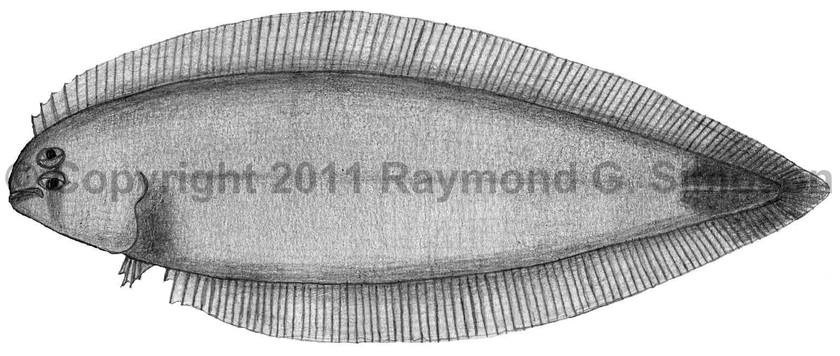
Common Name
Margined Tonguefish
Year Described
Goode and Bean, 1886
Identification
Dorsal Fin Rays: 93-104
Anal Fin Rays: 80-89
Pectoral Fin Rays: none
Pelvic Fin Rays: 4
Caudal Fin Rays: 12
Longitudinal Scale Rows: 86-99
Vertebrae: 51-56
Pterygiophore pattern (1st three interneural spaces): 1-3-2
Other diagnostic characters include: pupillary operculum absent, ocular side premaxilla with teeth on the anterior 4/5 or entirely toothed, ocular side of lower jaw without fleshy ridge, ocular side dentary completely toothed, scales absent on blind side of dorsal and anal fins, and 4 (sometimes 5) hypurals.
Color
Uniformly dark brown with no banding. A large dark blotch is present on the caudal region of body, extending onto caudal fin and rear of dorsal and anal fins. Peritoneum black. Dorsal and anal fins with dark pigment at the base and lighter distally, becoming all dark at the caudal blotch. Blind side pale without melanophores.
Size
Usually from 80-120mm. Maximum size to 146mm.
Habitat
Outer continental shelf to the upper continental slope from 37-832m (usually 320-550m), over soft mud bottoms.
Range Map

Range
NJ to the NE Gulf of Mexico, the Caribbean Sea, to southeastern Brazil
References
Munroe, T.A. 1998. Systematics and ecology of western Atlantic tonguefishes (Symphurus: Cynoglossidae: Pleuronectiformes). Fish. Bull. 96(1):1-182.
Munroe, T. A. 2003. Bothidae (Pp. 1885-1895), Scophthalmidae (Pp. 1896-1897), Paralichthyidae (Pp. 1898-1921), Poecilopsettidae (Pp. 1922-1923), Achiridae (Pp. 1925-1933), Cynoglossidae (Pp. 1934-1959). In: Carpenter. 2003. The living marine resources of the Western Central Atlantic v. 3.